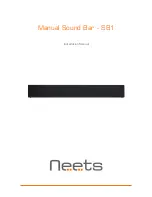
Cetetherm Mini Plus CM737
Installation, service and operating instruction
7
4
Installation
4.1
Unpacking
•
Remove the transport packaging and check that the product has not been damaged in transit and that
the consignment agrees with the specifications.
•
When lifting the unit, take care not to apply stress to pipes and heat exchangers as this may weaken
them. Avoid lifting the unit by holding the heat exchangers.
Note
: Risk of injury lifting heavy objects.
4.2
Preparation
•
Choose a suitable installation area in accordance with official regulations.
The system may generate sounds during operation caused by pumps, regulators systems, flows etc.
This should be taken into consideration during installation of the unit, so that possible operational
sounds affect the surroundings as little as possible. This means that the system should be installed on
well-insulated walls, such as outer walls or on concrete walls.
•
Check the applicable regulations of the district heating supplier. The available differential pressure
should be at least 100 kPa and at most 600 kPa. Where the differential pressure is higher, a differential
pressure controller should be added to the installation.
•
Flush out the heating and hot water systems.
4.3
Mounting
•
Mount the substation on the wall using four screws or bolts suitable for the material of the wall and for
the weight of the unit. The unit may be mounted at any height on the wall, 1500
– 1800 mm from floor
to keyhole fixing may be taken as a guide. The hole pattern for screws/bolts and the piping connection
measures is shown in
•
Install enclosed check valve for cold water in cold water pipe.
Picture 2; Installation of check valve in cold water pipe.
•
Connect the pipe work to the connection points. Use the enclosed shutoff valves with flat contact face.
•
Drainage pipes from safety valves must be taken to floor gully.
•
Energy meters must be installed at a prepared location, replacing a gauge block, or following the
instructions of the energy supplier.
•
Retighten all connections, including those made at the factory. If connections need retightening after
the installation has been taken into service, the system should be depressurised before retightening. If
the system is not depressurised before retightening, gaskets will be damaged.
•
Mount the outdoor temperature sensor on the north side of the building, 2 metres above the ground, or
higher. For installation of the outdoor temperature sensor, see
7.2 Installing the outdoor temperature
•
For installation of the operator control panel see
Using the control panel as a room thermostat










































